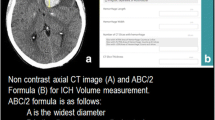Abstract
Background
Emergency reversal of the international normalized ratio (INR) in patients who develop nontraumatic subdural hemorrhage (SDH) due to oral anticoagulants (OAC) represents a primary treatment strategy but it is difficult to predict the amount of prothrombin complex concentrate (PCC) needed for reversal treatment. Moreover, repeated INR testings in central laboratories (CL) are time consuming. The usefulness of point-of-care INR coagulometers (POC) to test the success of INR reversal in OAC-SDH has not yet been investigated.
Methods
Prospectively, INR reversal was performed by administering PCC to patients suffering from acute SDH-OAC using a predefined dosing schedule. Accuracy and time gained by using POC were assessed and compared with CL measurements.
Results
A total of 10 patients were treated according to the protocol (male: 5). Bland–Altman analysis between POC and CL revealed a mean INR deviation of 0.013 for initial INR values and of 0.081 during reversal treatment. Using POC, the median initial net time gain (accounting for clinical examination and CT) for the start of PCC was 21 min. Median total time for POC-documented reversal was 27 min, as compared to 70 min for CL. The shortest interval between head CT and start of emergency SDH evacuation surgery was 37 min. By employing stepwise POC-guided reversal of the anticoagulatory effect of OAC, the calculated PCC dose could be reduced by 25% in the median.
Conclusions
Using POC to measure INR values and patient-adapted PCC administration is a fast and economic method to reverse anticoagulation in patients with acute OAC-SDH.


Similar content being viewed by others
References
Hanley JP. Warfarin reversal. J Clin Pathol. 2004;57:1132–9.
De Wilde S, Carey IM, Emmas C, Richards N, Cook DG. Trends in the prevalence of diagnosed atrial fibrillation, its treatment with anticoagulation and predictors of such treatment in UK primary care. Heart. 2006;92:1064–70.
Connolly SJ, Ezekowitz MD, et al. Dabigatran versus Warfarin in patients with atrial fibrillation. NEJM. 2009;361:1139–51.
Bershad EM, Farhadi S, Suri MF, Feen ES, Hernandez OH, Selman WR, Suarez JI. Coagulopathy and inhospital deaths in patients with acute subdural hematoma. J Neurosurg. 2008;109:664–9.
Hart RG, Boop BS, Anderson DC. Oral anticoagulants and intracranial hemorrhage. Facts and hypotheses. Stroke. 1995;26:1471–7.
Depreitere B, Van Calenbergh F, van Loon J. A clinical comparison of non-traumatic acute subdural haematomas either related to coagulopathy or of arterial origin without coagulopathy. Acta Neurochir. 2003;145:541–6.
Schneck MJ, Maheswaran M, Leurgans S. Predictors of outcomes after nontraumatic subdural hematoma. J Stroke Cerebrovasc Dis. 2004;13:192–5.
Ansell J, Hirsh J, Hylek E, Jacobson A, Crowther M, Palareti G. Pharmacology and management of the vitamin K antagonists: American College of Chest Physicians Evidence-Based Clinical Practice Guidelines (8th edition). Chest. 2008;133:160S–98S.
Rizos T, Jenetzky E, Herweh C, Hug A, Hacke W, Steiner T, Veltkamp R. Point-of-care reversal treatment in phenprocoumon-related intracerebral hemorrhage. Ann Neurol. 2010;67:788–93.
Junagade P, Grace R, Gover P. Fixed dose prothrombin complex concentrate for the reversal of oral anticoagulation therapy. Hematology. 2007;12:439–40.
Steiner T, Kaste M, Katse M, Forsting M, Mendelow D, Kwiecinski H, Szikora I, Juvela S, Marchel A, Chapot R, Cognard C, Unterberg A, Hacke W. Recommendations for the management of intracranial haemorrhage—part I: spontaneous intracerebral haemorrhage. The European Stroke Initiative Writing Committee and the Writing Committee for the EUSI Executive Committee. Cerebrovasc Dis. 2006;22:294–316.
Broderick J, Connolly S, Feldmann E, Hanley D, Kase C, Krieger D, Mayberg M, Morgenstern L, Ogilvy CS, Vespa P, Zuccarello M. Guidelines for the management of spontaneous intracerebral hemorrhage in adults: 2007 update: a guideline from the American Heart Association/American Stroke Association Stroke Council, High Blood Pressure Research Council, and the Quality of Care and Outcomes in Research Interdisciplinary Working Group. Stroke. 2007;38:2001–23.
Anon. Guidelines on oral anticoagulation: third edition. Br J Haematol. 1998;101:374–87.
Ansell J, Hirsh J, Dalen J, Bussey H, Anderson D, Poller L, Jacobson A, Deykin D, Matchar D. Managing oral anticoagulant therapy. Chest. 2001;119:22S–38S.
Baker RI, Coughlin PB, Gallus AS, Harper PL, Salem HH, Wood EM. Warfarin reversal: consensus guidelines, on behalf of the Australasian Society of Thromb Haemost. Med J. 2004;181:492–7.
Kohler M, Hellstern P, Lechler E, Uberfuhr P, Muller-Berghaus G. Thromboembolic complications associated with the use of prothrombin complex and factor IX concentrates. Thromb Haemost. 1998;80:399–402.
Rizos T, Herweh C, Jenetzky E, Lichy C, Ringleb PA, Hacke W, Veltkamp R. Point-of-care international normalized ratio testing accelerates thrombolysis in patients with acute ischemic stroke using oral anticoagulants. Stroke. 2009;40:3547–51.
Green TL, Mansoor A, Newcommon N, Stephenson C, Stewart E, Hill MD. Reliability of point-of-care testing of INR in acute stroke. Can J Neurol Sci. 2008;35:348–51.
Steiner T, Rosand J, Diringer M. Intracerebral hemorrhage associated with oral anticoagulant therapy: current practices and unresolved questions. Stroke. 2006;37:256–62.
Aguilar MI, Hart RG, Kase CS, Freeman WD, Hoeben BJ, Garcia RC, Ansell JE, Mayer SA, Norrving B, Rosand J, Steiner T, Wijdicks EF, Yamaguchi T, Yasaka M. Treatment of Warfarin-associated intracerebral hemorrhage: literature review and expert opinion. Mayo Clin Proc. 2007;82:82–92.
Pabinger I, Brenner B, Kalina U, Knaub S, Nagy A, Ostermann H. Prothrombin complex concentrate (Beriplex P/N) for emergency anticoagulation reversal: a prospective multinational clinical trial. J Thromb Haemost. 2008;6:622–31.
Bland JM, Altman DG. Statistical methods for assessing agreement between two methods of clinical measurement. Lancet. 1986;1:307–10.
Lee SB, Manno EM, Layton KF, Wijdicks EF. Progression of warfarin-associated intracerebral hemorrhage after INR normalization with FFP. Neurology. 2006;67:1272–4.
Brody DL, Aiyagari V, Shackleford AM, Diringer MN. Use of recombinant factor VIIa in patients with warfarin-associated intracranial hemorrhage. Neurocrit Care. 2005;2:263–7.
Acknowledgments
We thank the nursing staff and the physicians of the neurological emergency room for help with INR measurements. R.V. is supported by an Else-Kröner Memorial Scholarship.
Author information
Authors and Affiliations
Corresponding author
Rights and permissions
About this article
Cite this article
Rizos, T., Jenetzky, E., Herweh, C. et al. Fast Point-of-Care Coagulometer Guided Reversal of Oral Anticoagulation at the Bedside Hastens Management of Acute Subdural Hemorrhage. Neurocrit Care 13, 321–325 (2010). https://doi.org/10.1007/s12028-010-9443-1
Published:
Issue Date:
DOI: https://doi.org/10.1007/s12028-010-9443-1




